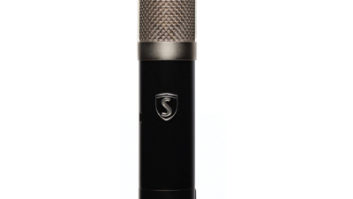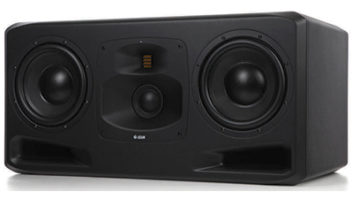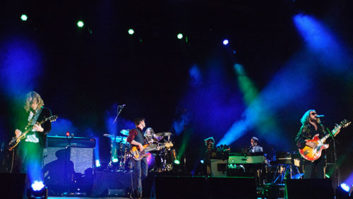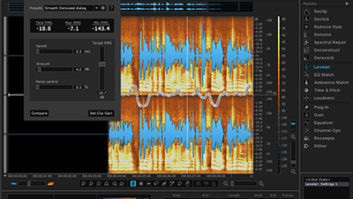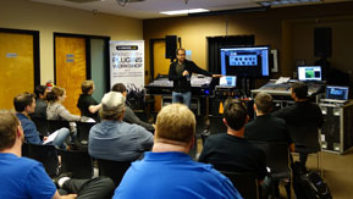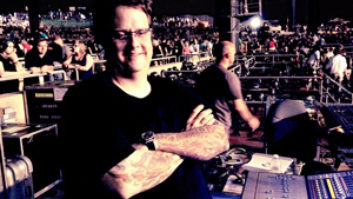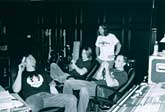

Alter Bridge is, from left, Scott Phillips (drums), Myles Kennedy (vocals/guitar),
Brian Marshall (bass) and Mark Tremonti (guitar/vocals).
Photo: Pamela Littky
Alter Bridge, an Orlando, Fla. — based newly signed rock act on Wind-Up Records, faces the universal challenge encountered by bands releasing a debut album: the long, hard road to Gold and Platinum status and the even longer path to multi-Platinum or Diamond RIAA sales. But selling albums by the truckload is not an alien concept to the members of Alter Bridge: Three-fourths of the group were founding members of Creed, the late-’90s band that lived a rock ‘n’ roll Cinderella story and stealthily dominated what was then called alternative rock radio, subsequently selling more than 30 million CDs worldwide.
Alter Bridge is hopeful that One Day Remains — their new album produced by Ben Grosse — will be embraced by Creed fans and those who never cared for the distinctive vocal style of Creed’s former lead vocalist, Scott Stapp. Still, these seasoned musicians are thoroughly aware that lightning rarely strikes in the same place twice. With that in mind, the band — which includes former Mayfield Four vocalist Myles Kennedy and ex-Creed members Mark Tremonti (guitar), Brian Marshall (bass) and Scott Phillips (drums) — proceeded with a clear mission: to record the best rock album they can and have fun doing it.

If anything, abandoning a name synonymous with success, bringing in a new, stylistically different vocalist and instigating a musical rebirth speaks volumes about the confidence Alter Bridge has in its music. “As Creed, we achieved a lot of success and we know what that’s like,” explains Phillips. “Now, our priority is to have a good time and to perform some of the best music that we’ve ever done. We just can’t wait to unleash Myles, our new monster singer, on the world.”
While recording Weathered, Creed’s last studio album, Tremonti and Phillips became interested in learning Pro Tools. Engineer Shilpa Patel was a Pro Tools operator for Creed during the Weathered sessions, and as the founder of Orlando’s Center for Pro Tools training school, was the perfect person to get the guys tooled up. Marshall — no longer a Creed member by the Weathered era — stayed busy recording projects at home on his own Pro Tools unit. After agreeing to collaborate on the Alter Bridge project, the three began an industrious Pro Tools — based songwriting system.
“That’s why so many artists are learning Pro Tools and buying systems these days,” reasons Patel, who is also credited as Pro Tools op for the Alter Bridge sessions. “It’s a completely different world from putting down ideas on an old 4-track or something. If Mark records something at his house, he can take it over to Flip [Phillips] or Brian. It gives them another way to be closely involved in the recording process through showing the engineer what they want by doing it first.”
This proved to be especially useful during their lead vocalist search. “It made a huge difference,” explains Phillips. “Mark would do Pro Tools demos — he initially gave Myles eight or nine songs — instead of giving him a tape or a CD. Myles would then be able to put his vocals down on the files and it turned out to be amazing. That kind of flexibility is great for working together as a band.”
As a side effect of becoming so Pro Tools savvy, the members of Alter Bridge became extremely particular in selecting a producer for One Day Remains. While very proud of the Creed back catalog, Alter Bridge — along with Wind-Up and the band’s management — chose to recruit fresh production expertise.
“We agreed that it would be a better idea to use a different production team, get away from any comparisons with Creed and really make this stand on its own,” Tremonti recalls. “I was talking to John Connelly from Sevendust and he said that the best producer he had ever worked with was Ben Grosse. I talked to Scott about it and he said, ‘Dude, I’ve been telling you about him for the longest time!’”
Grosse gladly accepted the invitation. From the beginning, Grosse shared Alter Bridge’s objectives for One Day Remains. “The general goal was to make this not be a Creed record, but with that same level of quality in the songs,” explains Grosse. “And it does. I’m shooting for a big, juicy, cinematic sound to set the tone for a new band.”
Alter Bridge soon found themselves with Grosse and his recurrent engineer, Blumpy, at Atlanta’s Tree Sound Studios to begin recording basic tracks. Because of the immediate need for a single, the production team tracked drums for the whole album and all tracks for three complete songs at Tree before heading to Grosse’s The Mix Room in Burbank, Calif., for mixdown. “We needed to have a single out before the album was finished,” explains Grosse. “We didn’t know what the single would be, so we picked three songs and finished those.”
Alter Bridge tracked live in Tree’s Studio A, which features a Solid State Logic 4064 G+ console and main monitor system by George Augspurger. The console was only used for monitoring, however. “We used as many vintage Neve mic preamps as we could get our hands on, no compression and recorded directly to Pro Tools,” says Blumpy. “They were all playing in the same room, including the singer. At that point, it’s all about the drummer and if he’s getting the vibe. I know that a lot of people don’t go this way because of isolation issues, but the vibe is most important. It just needs to rock.”
Those rocking drum tracks went down via a Neumann U47 FET on the kick, a combination of AKG C 414s and Sennheiser MD 421s on toms, “lots of Shure SM57s” scattered about and Cole 4038 ribbon mics for the room — a “pretty standard selection,” according to Blumpy. “For drums, we take as many tracks as we can. At mix, we might use the overheads if it’s a rocking tune, but if it’s a slower song, we might not use the overheads and use direct cymbal tracks. We get it covered like a blanket and we take out what we don’t need.”
Following the early mix of the first three songs in L.A., the Alter Bridge sessions returned to the South, but this time to Tremonti’s lakefront home in a posh Orlando suburb. The home, which was in the final stages of construction during the sessions, served as a great location to record guitars, bass and vocals for the rest of the album due to its high ceilings, absence of furniture and acoustic flexibility. “What’s now unique about this project is that we’re recording in a castle,” Grosse jokes while pointing out of a French Gothic — styled window overlooking Tremonti’s back yard and large pool.
However, recording drums at Tremonti’s home was never a consideration. “Even if you could make one of the rooms sound right for drums,” Blumpy explains, “you would still have to rent all the equipment for it to be doable. Between the cabling, all the mic preamps and being able to hear, it was best to go to Tree.”

While recording at Tremonti’s home, Alter Bridge used the second floor’s largest space as a temporary control room. The Pro Tools|HD recording rig used a mostly Neve 1073 front end with a Midas live console.
Photo: Strother Bullins
The second floor of Tremonti’s home hosted Alter Bridge’s makeshift modular studio setup. One large room acted as the main control room — equipped with a Midas live console strictly used for monitoring purposes — while other treated spaces served as overdub locations. Arguably the most crucial room to the production was Tremonti’s amplifier room, a sizable space fully lined with various amp selections, centered on Tremonti’s favorite amp, the Mesa Boogie Dual Rectifier. “We threw up a bunch of different things and combined them,” explains Blumpy. “Again, it’s all about keeping the vibe going, so we set up as much stuff as possible. That way, there’s only a little bit of work to do when we want to make changes.”
For guitar amp microphones, the band used “lots” of Shure SM57s, an AKG 414, an Audix D6, a BLUE Dragonfly, a pair of Royer 122s and two Cole 4038s, one of which almost lasted the whole project. “Mark does that ‘chug’ thing and on the very last song, one of the Coles popped,” explains Blumpy. “That’s fine, because it sat there in the same spot the whole time. One last song, one chunk, and that was it.” To record Kennedy’s vocals, a microphone shoot-out ensued between a Neumann M49, AKG C 12 VR, Neumann U47 and a Telefunken ELAM 251. The Telefunken won and was used with a Neve 1073 and EAR 660 Fairchild-type limiter/compressor straight to Pro Tools.

A Mesa Boogie–dominated wall of guitar cabinets fills Tremonti’s makeshift amp recording room. An AKG 414, Audix D6, BLUE Dragonfly, Cole 4038 and several Shure SM57s capture the sounds of this mighty rig.
Photo: Strother Bullins
While there were plenty of guitar tracks recorded for the Alter Bridge album, Blumpy claims that he and Grosse have dramatically simplified their means of track management. “When we were first able to have 64 tracks of Pro Tools,” recalls Blumpy, “we’d dump each cabinet to its own track and not have enough outputs at mix, so we’d then combine them to one output together. We’d then wonder, ‘Why are we making this such a pain in the ass for ourselves?’ So we started to just cut all the cabinets we used to one track. That’s how we do it now: one track, one take. In the end, we never end up modifying what we were recording on separate tracks, so why go through the hassle of mixing all these different options? It keeps things straightforward for mixing — every track has an output and it all goes to the board.”
On the home’s first floor, Blumpy set up a Mac-based edit suite running Pro Tools and Emagic Logic. “I’m a Logic guy,” he explains. “I transfer the songs over to Logic, work on them and transfer them back to Pro Tools. I’ve been using Logic for years and do so in a dual configuration, running TDM and native hardware so I have both options. For more effected stuff, I always do it in Logic. It just sounds better to me. I love the fact that I have so many options in Logic, and for sound design stuff, Logic blows away Pro Tools.”
Grosse claims that he wouldn’t have normally chosen to partially track an album, mix and then continue tracking, but he admits that it did give him an interesting perspective for completing the rest of the record. “It’s sort of a double-edged sword,” he says in retrospect. “I would have preferred to finish the whole record, but there wasn’t time up front and we had to move. Now, after having finished three songs completely, it’s like I’m on the second album. I have experience, know what’s around the corner and know what problems may come up at the end of a song. This is something that you normally don’t have the luxury of knowing until you’re on a second album. It’s almost like you better understand the movie you’re making because you’ve watched it already.”
Strother Bullins is a North Carolina — based freelance writer specializing in the professional audio and entertainment industries.

• To listen to clips from Alter Bridge’s new album, One Day Remains,
click here.
